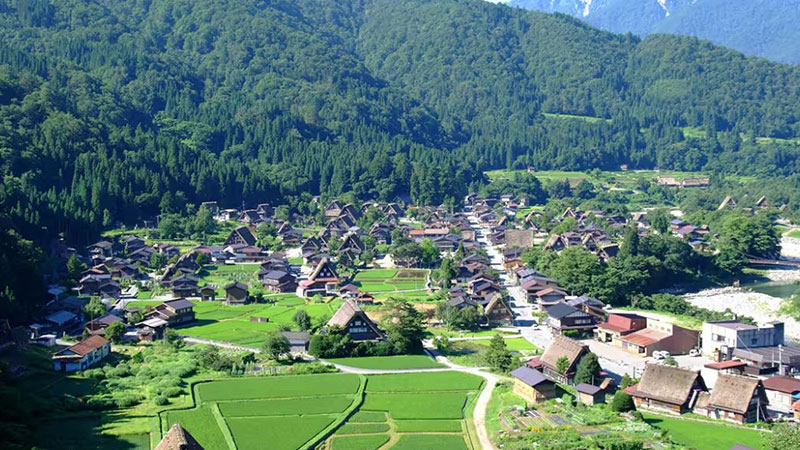Japan‘s Shimagar is a hidden village in the foggy mountains! Where the pristine nature is intertwined with the traditional lifestyle, as if its inhabitants have come out of history. The village is one of the few areas where the traditional Japanese lifestyle is still maintained. So in today’s modern world, traveling to Shimagar can be considered an exceptional opportunity to return to life with originality, simple and full of peace of mind. Join us for more familiarity with the cheerleader and its mood.
History
Japan’s Shimagar village is located in Komamoto province, Kiosho Island. The village is hundreds of years old, and after centuries the traditional structure of homes, agriculture style and local ceremonies are still preserved. Interestingly, the people of the village have been able to preserve and protect their cultural heritage despite numerous earthquakes and even urban development pressures.

Traditional architecture and Japanese houses in Shimagar
A unique example of traditional Japanese architecture can be seen in the village of Shimagar, Japan. The village houses are not only aesthetic, but also compatible with the environmental and climatic conditions of the region. Most of them are decades old and are made using natural materials such as wood, bamboo, straw and flowers, and their design is designed to match seasonal changes.
The key features of the architecture of the Shimagar house are the following:
Long -shaped roofs (kiabuki)
These types of ceilings are designed to prevent snow from accumulating in the winter and passing airflow in summer and are usually made of straw or wood. Their high slope causes rainwater or snow to flow quickly and not damage the house.
Mud and wooden walls
These walls are made using traditional techniques such as “Ducora” and are a good insulation against heat and cold.
Sliding doors (Shoji and Fusoma)
The thin doors of the houses of Shimagare village are made of rice and wood paper, and instead of open and closed, they slide on the rails. This type of design helps to enter natural light into the home.
Tatami flooring
Tatami is a kind of soft rice foam that gives the interior a sense of beauty, relaxation and intimacy.
Harmony with nature
The houses of the Japanese Shimagar Village are perfectly in line with the nature of the surroundings, having large windows to see mountain scenery as well as the use of natural materials that cause the least damage to the environment.

Lifestyle of Japanese Local People
The residents of Shimagar are most of the traditional farmers, fishermen or craftsmen. Agriculture is done on mountain steps with old techniques. Alongside it, people keep the traditions alive by making handicrafts such as bamboo baskets, natural textiles and clay containers. In this village, the high -speed Internet is scarce, but kindness, time with the family, and nature communication.
Read more: Introducing Unions: A Japanese Hot Springs World
Festival and local festivals
Shimagar has hosted a variety of festivals throughout the year, the most famous of which are Matsuri Fire. The festival is held to seek rain and blessings, which is accompanied by dance, traditional music, and the lighting of large torches. You can get to know one of the most authentic Japanese traditions if you have a chance to attend the festival.

The pristine nature of the mountain in the Japanese Shimagar
The village of Shimagare is located in the heart of the southern mountains of Japan and is surrounded by fog, dense trees and rivers. The nature of this area is so pristine and soothing that no tourist can withstand its beauty. The climate in the highlands has made the climate cool, pleasant and pleasant during the year.
The unique natural features of Japan’s Shimagar are the following:
- The rivers and springs that originate from the heart of the mountain. Natural hot springs are also found near the village, which have been used for centuries for treatment.
- The bamboo forests and the leaves of maple trees that fall into a range of red and orange throughout the year and create a magical view of nature photography.
- Shimagar Nights provide astronomical opportunities for astronomy to observe stars.
- Clean air, the voice of nature, green landscapes and relaxing silence offers a great opportunity for mental and mind.

Stay in the village of Shimagar: An unforgettable experience
Japan’s Shimagar gives a dream accommodation to its guests. In this village, tourists can stay in traditional rural houses (called Minnespa or host houses). This way you can experience local cuisine, participate in everyday activities such as harvesting agricultural products, traditional bread baking or wood work. Staying in Shimagar is an opportunity to communicate deeply with locals and touch their daily lives closely.
Read more: Visit Japanese Gardens in Spring | Art and nature in a frame
Ways to access the Japanese Shimagar village
It is easy to access the Shimagar through the Hitooshi train station. From there you can get to the village of Shimagar from there by local bus or taxi. This route may be a bit time consuming, but the path to the village is so beautiful that it will be part of the pure and different travel experience.

Final speech
Shimagar is not just a typical village; Many tourists in Japan’s Tour believe that the place to achieve peace in life is a return to the roots and window that takes you to the past world of Japan in today’s chaotic world. So if you are looking for a cultural, spiritual and human experience, travel to this village in your plan.
Frequently asked questions
Is it a good destination for foreign tourists?
There is no modern facilities in the village, but traditional resorts with excellent services and local guides provide a pleasant experience for foreigners.
What season is the best time to travel to Shimagar?
Spring and autumn are the best times to visit, because nature is in its most beautiful seasons.
Is it possible to access internet in the village?
Many parts of the village are not available on the Internet, but there are limited WiFi resorts.
Is village food suitable for vegetarians?
Most of the traditional cuisine of the cheerleaders includes vegetables, rice and local products. So there is food for every taste.
Copying the contents of the Vanak Star Airlines agency is solely with the source.
RCO NEWS













